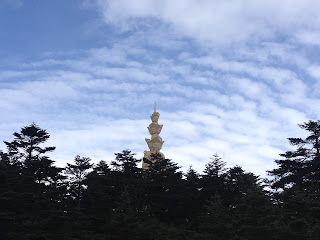Mid-trip Lindsay and I decided to get brave and try the Chengdu regional bus system out. Cue miming and general looks of panic. But it worked and we got tickets to the town of Emei home of Mt. Emeishan, one of Buddha's four sacred mountains in China. At 3,099 meters we prepared for cold weather, stairs and general national park ridiculousness.
After checking into the Teddy Bear Hotel (just as ridiculous as you might imagine), we made for a wander of the town and bought passes to enter the national park. All of this in mime. Our initial aim was to spend the night on the mountain in one of the many monasteries that offer cheap accommodation to pilgrims making the trek to the top. After being elbowed out of the way by a granny wielding 100 renmibi notes, we gave up on that dream. I'm still not cutthroat enough to elbow grannies out of the way.
Once we started the walk and not so curiously, the stairs were relatively empty in comparison to the hundreds of people queuing for the cable car to the top. Feeling hardy, we climbed and climbed and climbed. It took us no less than 10,000 steps and a journey through the valley of the monkeys to make it to the top.
After my Thailand monkey adventure, I steered clear of the large monkeys dotting public footpaths. I watched in horror as Chinese tourists ignored the 'do not feed the monkeys' signage and were subsequently stalked by primates who growled and lurched viciously for their salty snacks.
Wikitravel's page on Mt. Emeishan devotes nine lines to the monkeys in the 'Danger and Annoyances' section apportioning the use of bolded capital letters to attest to their danger: 'Be aware of the thieving monkeys, have lost their fear of humans due to unregulated handouts of junk-food from Chinese tourists and note that they can be VERY AGGRESSIVE and dangerous more so than cute. Caution is strongly advised. Some people take sticks for their defense. It is very important not to carry anything in your hands such as bags, bottles, plastic or anything shiny or eatable. It is advisable not to look them in the eyes, since it can be perceived as a sign of aggression.'
Lindsay snapped photos and I hid by checking out the various viewpoints and signs pleading with me not to jump:
Three hours in our epic climb the feeling in our legs began to burn beyond recognition. We contemplated giving up until two things happened. First, we reached signs of life. Only the Chinese would build a foot court at the top of a sacred mountain:And as we marvelled at this in the middle of a set of stairs, we became curiously aware of the fact that we were blocking the way and a Chinese couple loomed near us. I jumped out of the way only for the woman to kind of shove her husband towards us, smile and snap a photo. Before we had any time to react, she threw her phone to her husband, grabbed Lindsay and my hands and shoved herself between us. Pulling us close she smiled and smiled and smiled while her husband snapped away. Now, we're famous on the wall of some couple whose main happiness in life was taking a photo with two Western tourists.
Closer to the top it got better and better. The Golden Summit loomed in the distance and prompted us to the summit:
Closer:

With Buddha looking in all directions, we were always being watched. But the weather cleared up in some feat of delight and we could see for miles.
As a sacred place, people also lit up their incense and said their prayers:
I will, one day, update this with photos from my camera which are much farther reaching and comprehensive. In the meantime, I leave you with my best impression of a royal elephant:












No comments:
Post a Comment